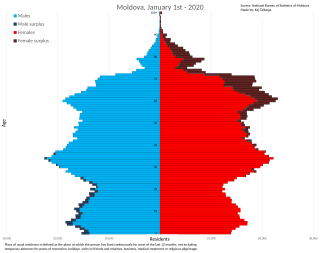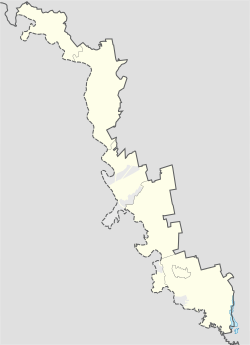
Demographic features of the population of Republic of Moldova include distribution, ethnicity, languages, religious affiliation and other statistical data.

Tiraspol is the capital and largest city of Transnistria, a breakaway state of Moldova, where it is the third-largest city. The city is located on the eastern bank of the Dniester River. Tiraspol is a regional hub of culture, economy, tourism, and light industry, such as furniture and electrical goods production.

Transnistria, officially known as the Pridnestrovian Moldavian Republic and locally as Pridnestrovie, is a breakaway state internationally recognized as part of Moldova. It controls most of the narrow strip of land between the Dniester river and the Moldova–Ukraine border, as well as some land on the other side of the river's bank. Its capital and largest city is Tiraspol. Transnistria is officially designated by the Republic of Moldova as the Administrative-Territorial Units of the Left Bank of the Dniester or as Stînga Nistrului.

Bender or Bendery, also known as Tighina, is a city within the internationally recognized borders of Moldova under de facto control of the unrecognized Pridnestrovian Moldavian Republic (Transnistria) (PMR) since 1992. It is located on the western bank of the river Dniester in the Romanian historical region of Bessarabia.
The history of the Jews in Bessarabia, a historical region in Eastern Europe, dates back hundreds of years.

Grigoriopol is a town in the Administrative-Territorial Units of the Left Bank of the Dniester, Moldova. It is the seat of the Grigoriopol District of Transnistria. The city is located on the left (eastern) bank of the river Dniester, in central Transnistria.

The Transnistria War was an armed conflict that broke out on 2 November 1990 in Dubăsari between pro-Transnistria forces, including the Transnistrian Republican Guard, militia and neo-Cossack units, which were supported by elements of the Russian 14th Army, and pro-Moldovan forces, including Moldovan troops and police.

Pavel Aleksandrovich Krushevan was a journalist, editor, publisher and an official in Imperial Russia. He was an active Black Hundredist and known for his far-right, ultra-nationalist and openly antisemitic views. He was the first publisher of The Protocols of the Elders of Zion.

The history of the Jews in Moldova reaches back to the 1st century BC, when Roman Jews lived in the cities of the province of Lower Moesia. Bessarabian Jews have been living in the area for some time. Between the 4th-7th centuries AD, Moldova was part of an important trading route between Asia and Europe, and bordered the Khazar Khaganate, where Judaism was the state religion. Prior to the Second World War, violent antisemitic movements across the Bessarabian region badly affected the region's Jewish population. In the 1930s and '40s, under the Romanian governments of Octavian Goga and Ion Antonescu, government-directed pogroms and mass deportations led to the concentration and extermination of Jewish citizens followed, leading to the extermination of between 45,000-60,000 Jews across Bessarabia. The total number of Romanian and Ukrainian Jews who perished in territories under Romanian administration is between 280,000 and 380,000.

The Transnistria conflict is an ongoing frozen conflict between Moldova and the unrecognized state of Transnistria. Its most active phase was the Transnistria War. There have been several attempts to resolve the conflict, although none have been successful. The conflict may be considered as having started on 2 September 1990, when Transnistria made a formal sovereignty declaration from Moldova.

This is the history of Transnistria, officially the Pridnestrovian Moldavian Republic (PMR), an unrecognised breakaway state that is internationally recognised as part of Moldova. Transnistria controls most of the narrow strip of land between the Dniester river and the Moldovan–Ukrainian border, as well as some land on the other side of the river's bank.

The Romanian-language schools in Transnistria are subject to limitations by the government of Transnistria, an unrecognized breakaway region of Moldova since 1992.

The Pridnestrovian Moldavian Soviet Socialist Republic (PMSSR), also commonly known as Soviet Transnistria or simply as Transnistria, was created on the eastern periphery of the Moldavian Soviet Socialist Republic (MSSR) in 1990 by pro-Soviet separatists who hoped to remain within the Soviet Union when it became clear that the MSSR would achieve independence from the USSR and possibly unite with Romania. The PMSSR was never recognised as a Soviet republic by the authorities in either Moscow or Chișinău. In 1991, the Pridnestrovian Moldavian Republic succeeded the Pridnestrovian Moldavian Soviet Socialist Republic.

A demographic history of Transnistria shows that Transnistria has been home to numerous ethnic groups, in varying proportions, over time.

This timeline of events is a chronological list of incidents and other notable occurrences related to the War of Transnistria, including events leading up to the war.
Doibani I is a commune in the Dubăsari District of Transnistria, Moldova. It is composed of three villages: Coicova, Doibani I and Doibani II. It has since 1990 been administered as a part of the breakaway Pridnestrovian Moldavian Republic. According to the 2004 census, the population of the village was 1,901 inhabitants, of which 925 (48.65%) were Moldovans (Romanians), 754 (39.66%) Ukrainians and 168 (8.83%) Russians.
Dubău is a commune in the Dubăsari District of Transnistria, Moldova. It is composed of two villages, Dubău and Goianul Nou. Since 1990, it has been administered as a part of the breakaway Pridnestrovian Moldavian Republic. In 2004, the commune had 724 inhabitants, of which 675 were Moldovans (93.23%), 31 were Ukrainians (4.28%) and 16 were Russians (2.21%).
Harmațca is a village in the Dubăsari District of Transnistria, Moldova. It has since 1990 been administered as a part or the breakaway Pridnestrovian Moldavian Republic.

Țîbuleuca is a village in the Dubăsari District of Transnistria, Moldova. It has since 1990 been administered as a part of the breakaway Pridnestrovian Moldavian Republic.

The battle of Bender, also known as the battle of Tighina or the battle of Bendery, was fought between 19 and 21 June 1992 between Moldova, backed by volunteers, military advisors and bought weapons from Romania; and the Pridnestrovian Moldavian Republic, an unrecognized breakaway state that declared independence from Moldova and relied on direct military support from Russia. The battle occurred in Bender, also known as Tighina, a city with a strong ethnic Russian presence at the western bank of the Dniester River. This is different from the rest of currently Transnistrian-controlled lands, which are located at the eastern bank of it. Bendery is the Russian name of the city and Tighina is the Romanian one, with Bender being an old Ottoman name.




















